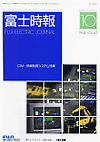FUJI ELECTRIC JOURNAL Vol.67-No.10 (Oct/1994)
 |
CIM and Information Processing Systems |
Fuji Electric's CIM/Information Processing Systems
Masaji Kawata
ith progress in computer downsizing, open system and network technology, personal computers and work stations are expected to transform centralized processing computer systems into distributed processing ones. In information processing system constructions in companies, client-server systems (CSSs) using personal computers and work stations have begun to obtain excellent results, and there is much need for distributed processing systems, including CSSs. This paper introduces Fuji Electric's distributed CIM systems.
Open Systems for Electronic Manufacturer Factory Routines
Masayuki Takahashi, Hiromitsu Oda, Toyoshige Sato
Owing to computer downsizing, open system and network technology, centralized processing systems have been transforming into distributed processing ones. And then in production control systems, the advanced performance of personal computers as well as enhanced software has enabled users to develop and maintain software by themselves. This paper introduces an example of a system which rationalized factory routines using personal computers.
Distributed Production Control System in the Suzuka Inverter Factory
Sadanao Sato, Susumu Ichikawa
To meet market changes sensitively and satisfy users, Fuji Electric solved the mutually contradictory production control problem of prompt delivery and minimized stock and has realized a distributed system to produce a required number of required units at the time required by users by re-engineering with the UNIX client-server system. This paper describes the following three points:computer-integrated manufacturing (CIM) with logistics integrating manufacture and sale, CIM production schedule reservation control system, and the subsystems for the above:material and distribution requirements planning (MRP and DRP).
Network System Application in a Rotating Machinery Factory
Kazuyoshi Furuichi, Mitsuo Fukase, Shoichi Kanehisa
The assembly preparation division of Fuji Electric's rotating machinery factory developed a network system using personal computers to perform parts control, machining progress control before assembly, assembly instructions, conveyance instructions, packaging notices, etc. This system was developed at a low cost in a short period of time by making the most of existing software packages. This paper gives an outline of the system.
Batch Processing Brand Control System
Yasuo Ito, Minoru Yoshino, Toshifumi Yamachi
In a batch plant for variable model, variable quantity production, there are often product brand changes and new brand additions, which the measuring and control system of the plant must be able to meet flexibly. This paper describes a batch processing brand control system which can easily be prepared and maintained by classifying the sequences by functions and arranging them in a hierarchical structure.
Coil Yard Computer System
Eiji Kakou, Takashi Tsuda, Hiroshi Soma
This paper outlines the computer system introduced to apply factory automation to the coil yard of Kure Works, Nisshin Steel Co., Ltd. This system aims at labor-saving operation, quality improvement by preventing foreign matter from intruding, improved safety of operators, downsizing from the business computer. The system is roughly divided into three processing systems:database, man-machine, and conveyance instruction systems. These functions are controlled by four distributed computers. AI processing with AIMAX-C is also introduced to make refinement scheduling and coil distribution prediction.
Factory Automation System for Epitaxial Wafer Manufacturing
Tetsuo Kitazume, Masaru Inomata, Toshio Doi
With the automation and mechanization of production lines, to improve productivity and secure high quality, high level judgment by the operator such as the setting of operating methods and production standards and the regulation of operating ratios has become essential. This paper introduces a computer-aided operation support system for productivity improvement and standardized operation in an epitaxial wafer production line which calculates the complicated conditions of production and quality and indicates optimum operating methods to the operator.
Delivery Center System for Trading Companies
Takeshi Narushima
Recently, reduction in distribution cost in marketing routes has been a serious problem to the distribution industry. Particularly for wholesalers and trading companies situated in the intermediate stage of distribution, this is an absolute condition to survive and therefore many large-scale delivery centers are erected. This paper clarifies the features of the delivery centers of trading companies, which are typical of the distribution industry, by comparing them to those of manufacturers, and describes functions and features required by the information system to control and operate the centers.
Information Processing System Components
Ryoichi Tokunaga
To construct an FA information system, it is necessary to combine ordinary OA information system components well with FA information system components suitable for the environment and work at the production site. This paper introduces the following three articles of commerce:FA terminals, picking indicators, and integrated drawing maintenance systems.
Power System Operation Support System for Superhigh Voltage Consumers
Tetsuya Koide, Fumihiko Hirose, Atsushi Sato
With the growing complexity and sophistication of power systems for superhigh consumers, rationalization and labor reduction have increased operator load. This paper introduces a power system operation support system to cope with this situation. As system fault shooting support function, an expert system that supports fault analysis and restoring operation is constructed to grasp the fault exactly and shorten the time for restoration. The expert system construction support function comprises functions of system information preparation, fault simulation, and rule confirmation support, resulting in a user-friendly system.

